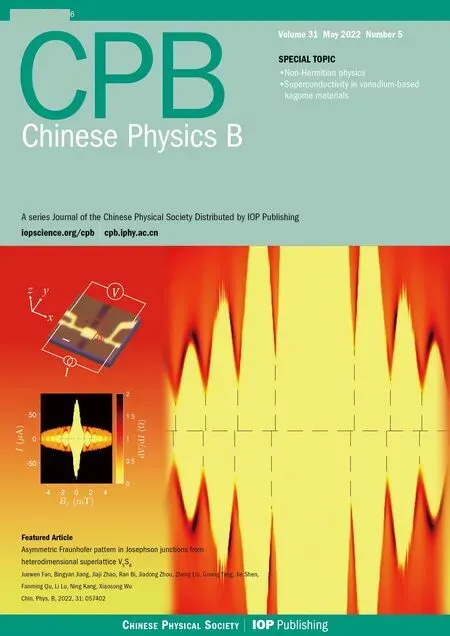Measurement of electronic structure in van der Waals ferromagnet Fe5-xGeTe2
Kui Huang(黄逵) Zhenxian Li(李政贤) Deping Guo(郭的坪) Haifeng Yang(杨海峰) Yiwei Li(李一苇)Aiji Liang(梁爱基) Fan Wu(吴凡) Lixuan Xu(徐丽璇) Lexian Yang(杨乐仙) Wei Ji(季威)Yanfeng Guo(郭艳峰) Yulin Chen(陈宇林) and Zhongkai Liu(柳仲楷)
1School of Physical Science and Technology,ShanghaiTech University,Shanghai 200031,China
2Shanghai Institute of Optics and Fine Mechanics,Chinese Academy of Sciences,Shanghai 201800,China
3University of Chinese Academy of Sciences,Beijing 100049,China
4Department of Physics and Beijing Key Laboratory of Opto-electronic Functional Materials&Micro-nano Devices,
Renmin University of China,Beijing 100190,China
5ShanghaiTech Laboratory for Topological Physics,ShanghaiTech University,Shanghai 201210,China
6State Key Laboratory of Low Dimensional Quantum Physics and Department of Physics,Tsinghua University,Beijing 100084,China
7Department of Physics,University of Oxford,Oxford OX1 3PU,United Kingdom
Keywords: angle-resolved photoemission spectroscopy,van der Waals ferromagnet,electronic structure
1. Introduction
Recently, van der Waals (vdW) ferromagnets have attracted great research attention because they provide a versatile playground to explore the nature of the low-dimensional magnetism and a rich material basis for future applications:the vdW ferromagnets in the 2D limit exhibit unusual properties such as large magnetic anisotropy, (quantum) anomalous Hall effect, long-range magnon transport, etc.[1—6]Furthermore, their virtue of easy exfoliation into few-layer limit makes them very convenient for constructing various novel heterostructures and devices, which would find potential applications in the next-generation spintronic devices, such as spin valves,spin—orbit torque,spin field-effect transistors,spin tunneling field-effect transistors,and spin-filter magnetic tunnel junctions.
In principle, in the isotropic 2D limit, the spontaneous symmetry breaking for the formation of intrinsic long-range magnetic order is generally prohibited by strong thermal fluctuations, which is known as the Merin—Wagner theorem.[7]Nevertheless, the long-range magnetic order has been realized in a broad range of vdW ferromagnets,such as in monoor few-layer CrI3,[1]Cr2Ge2Te6,[2]Cr2Si2Te6,[8]VSe2,[9]and MnSe2,[10]etc., owing to their intrinsic magnetocrystalline anisotropy.
Among all the vdW ferromagnets, FexGeTe2is an intriguing material class with large intrinsic anomalous Hall effect, high Curie temperature (Tc) and highly tunable magnetic properties with different chemical composition, layer thickness, and external gating.[11—15]As for Fe3GeTe2, while the transport and optical methods have revealed 2D itinerant ferromagnetism, previous angle resolved photoemission spectroscopy(ARPES)measurement has suggested signature for non-Stoner ferromagnetism,[13]therefore the origin of the magnetic ordering as well as its interplay with the electronic structure remains mysterious and requires further investigations.
To address the issue, the investigation of new member Fe5-xGeTe2becomes critical.[16—22]Fe5-xGeTe2shows the highestTc(from 270 K to 363 K depending on the Fe deficiencyx)among the FexGeTe2family,since the extra Fe layer in Fe5-xGeTe2can considerably enhance the magnetic interaction and stabilize the long-range magnetic order. However,limited by the much less study on Fe5-xGeTe2as compared with Fe3GeTe2,the underlying mechanisms for the room temperatureTcremain mysterious and the relation between the magnetic order and electronic structure in Fe5-xGeTe2requires further investigations.
In this work, we systematically studied the electronic structure of Fe5-xGeTe2using synchrotron-based ARPES and made the following discoveries. First, we have observed two kinds of band structures from two different cleaved terminations in Fe5-xGeTe2. Second,our photon energy dependence measurement shows clear periodicity of 2π/cin the electronic structure and slight variation in the band structure,which suggests the 2D nature of Fe5-xGeTe2. Finally, the temperature evolution of electronic structure of Fe5-xGeTe2suggests the merging of two bands which are~400 meV apart across the Curie temperature. We conclude that the exchange-splitting observed in the electronic structure indicates that the itinerant Stoner model properly describes the origin of ferromagnetism in Fe5-xGeTe2. Our observation provides important insights into the nature of ferromagnetism of Fe5-xGeTe2and other two-dimensional ferromagnetic materials.
2. Result and discussion
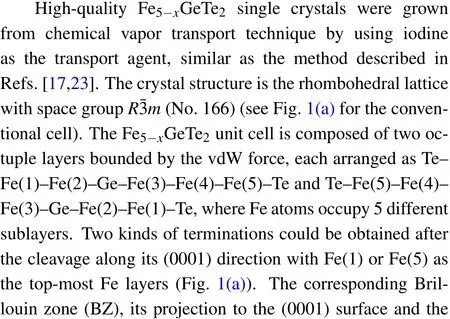


Fig.1.Basic characterization of Fe5-xGeTe2.(a)Crystal structure of Fe5-xGeTe2.Red,blue,and orange spheres indicate Te,Fe,and Ge atoms,respectively.(b) The Brillouin zone (BZ) of Fe5-xGeTe2. High-symmetry points are labeled. (c) Image of Fe5-xGeTe2 single crystal and XRD patterns along three different crystalline directions. (d)The temperature dependent magnetization of Fe5-xGeTe2. The ferromagnetic transition temperature is marked.
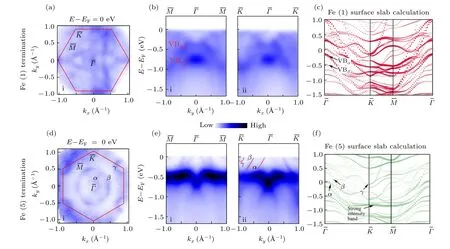
Fig. 2. Overall electronic structure of Fe5-xGeTe2 with two cleaved terminations. (a), (d) Photoemission intensity map of constant energy contours(CECs)in the kx—ky plane at EF of two cleaved terminations,respectively. The asymmetric pattern is due to the photoemission matrix element effect.(b),(e)Band dispersions along high-symmetryM—Γ—M andK—Γ—K of two cleaved terminations,respectively. (c),(f)Slab calculation of Fe5GeTe2 in the ferromagnetic state of two cleaved terminations,respectively. The integrated energy window of CECs is±50 meV.The data were collected using photons with hν =90 eV at 12 K.
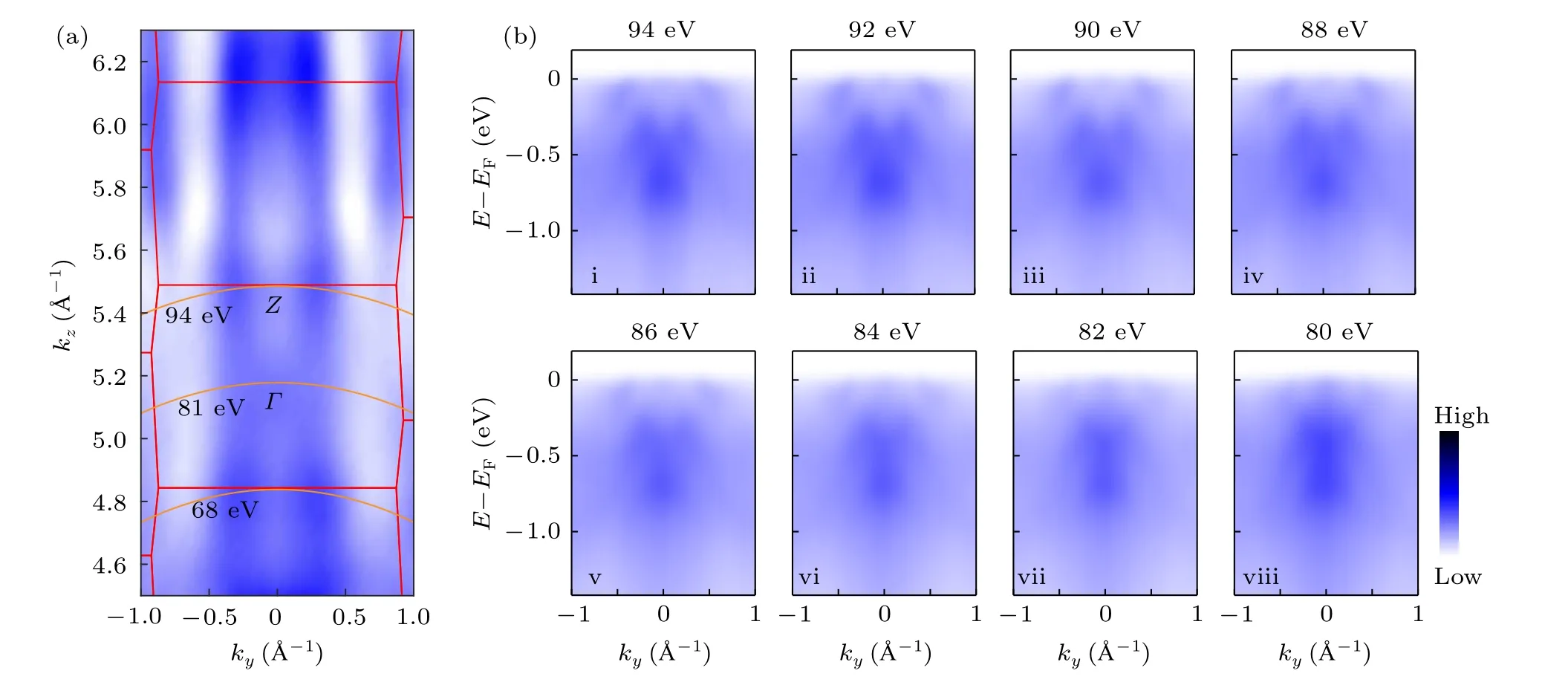
Fig.3. The kz evolution of the electronic structure of Fe5-xGeTe2. (a)Photoemission intensity map of the CEC in the kz—ky plane at 0.4 eV below EF. Red line indicates the BZ.The orange line represents the photon energy corresponding to the high symmetry point. (b)Band dispersions along high-symmetry M—Γ—M directions with different photon energy,respectively. The integrated energy window of CECs is±50 meV.The data were collected at 12 K.
To investigate the evolution of the electronic structure along thekzdirection, photon energy-dependent ARPES experiment was performed on Fe(1) termination with the result shown in Fig. 3. The CEC at 0.4 eV belowEFin theky—kzplane is plotted in Fig. 3(a), where clear periodic patterns are observed with a periodicity of 2π/c(the BZ is indicated by the red lines with high-symmetry points labeled), allowing us to determine the high symmetry points in the 3D BZ.Figure 3(b)shows the dispersion taken at photon energy from 80 eV to 94 eV along theM—Γ—Mdirection(which spans half of a BZ).While the energy band near the Fermi surface evolves slightly with the photon energy,the bands located at higher energies show nokzevolution,which reflects the 2D nature of the Fe5-xGeTe2compounds.
Finally,we examine the temperature evolution of the electronic bands from the ARPES data on Fe(1) termination. As shown in the plot of the original data of the ARPES intensity(Fig. 4(a)), we can see clearly that the splitting between the VBαand VBβbands becomes smaller as the temperature increases.When the temperature is higher than theTc(~270 K),VBαand VBβmerge into one energy band(indicated by VB).When the temperature drops back belowTc, VB splits into VBαand VBβagain,ruling out the band evolution due to simple sample aging. The change of the band splitting is also clearly shown by the side-by-side comparison of stacking plot of momentum distribution curves (MDCs) between the band structures at 12 K and 290 K(Fig.4(b)),as well as the temperature evolution of the EDCs atky=0.4 °A-1(Fig. 4(c)). We extract the peak positions of the VBαand VBβ,plot their evolution at various temperatures (Fig. 4(d)) and clearly see that the band splitting closes rapidly aboveTc.
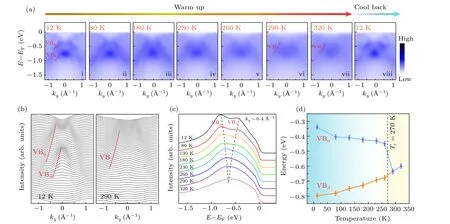
Fig. 4. Temperature evolution of the electronic structure of Fe5-xGeTe2. (a) Band dispersions along high-symmetryM—Γ—M directions at selected temperature. (b) The comparison of stacking plot of momentum distribution curves (MDCs) at 12 K and 290 K. The bands discussed are labeled. (c) The temperature evolution of EDCs at ky ~0.4 A°-1. (d)The energy position of VBα and VBβ bands as functions of temperature. The data were collected using 90 eV photons.

3. Conclusion
We have presented systematic investigation of the electronic structure of Fe5-xGeTe2. Our ARPES measurement revealed complete band structure from two different cleaved terminations. In addition, we observed a clear periodic pattern with a periodicity of 2π/cand exchange splitting of the valence band on the Fe(1) termination. Our results provide important experimental evidence of the electronic structure of Fe5-xGeTe2, and will also help to understand the magnetic origin and interaction between electrons and magnetic order of other two-dimensional ferromagnetic systems.
4. Method
4.1. Crystal growth
High-quality Fe5-xGeTe2single crystals were grown by using the chemical vapor transport technique via employing iodine as the transport agent. Mixtures of high purity elements including Fe, Ge, and Te with ratio of 6:1:2 were mixed and sealed in an evacuated quartz tube and slowly heated up to 700°C in a tubular furnace. After stayed at the temperature for 7 days,the assembly was slowly cooled down to room temperature.
4.2. Angle-resolved photoemission spectroscopy
The ARPES measurements were performed at BL03U station at Shanghai Synchrotron Radiation Facility (SSRF),China, beam line I05 of the Diamond Light Source (DLS),UK.The Fe5-xGeTe2single crystals were first elaborately selected and well prepared in air. Then they were cleavedin situalong the(001)surface without spoiling,and measured at a 12 K sample temperature in ultrahigh vacuum with a base pressure of lower than 7×10-11Torr. Data were recorded by a VG Scienta DA30 analyzer. The angle resolution was 0.2°and the overall energy resolutions were better than 15 meV.
4.3. Density functional theory calculations
DFT calculations were performed using the generalized gradient approximation for the exchange correlation potential with a plane-wave basis and the projector augmented wave method as implemented in the Viennaab initiosimulation package(VASP).[28—30]The energy cut-off for the plane wave was set to 700 eV for structural relaxation and 500 eV for electronic structure calculations,and thek-point sampling was 15×15×1. The slab is composed of two sub-layers, and the vacuum layer is larger than 15 °A. The Fe1 atoms are above the Ge atoms in each sub-layer. The structures were fully relaxed until the residual force per atom was less than 0.001 eV/°A. In structural relaxation calculations, dispersion correction was considered in the optB86b functional for the exchange potential.[31]DFT+Umethod[32]was used to better describe the strong correlation system in structural relaxation and electronic structures.U=1 eV was chosen in our calculations, and the lattice parametera=b=4.04 °A. Spin—orbit coupling effect and ferromagnetism were considered in electronic structure calculations.
Acknowledgments
This research used BL03U of Shanghai Synchrotron Radiation Facility and I05 of the Diamond Light Source.We also acknowledge the Analytical Instrumentation Center of ShanghaiTech University for x-ray diffraction and MPMS measurements. Z. K. Liu acknowledges the National Key R&D Program of China(Grant No. 2017YFA0305400).
- Chinese Physics B的其它文章
- A nonlocal Boussinesq equation: Multiple-soliton solutions and symmetry analysis
- Correlation and trust mechanism-based rumor propagation model in complex social networks
- Gauss quadrature based finite temperature Lanczos method
- Experimental realization of quantum controlled teleportation of arbitrary two-qubit state via a five-qubit entangled state
- Self-error-rejecting multipartite entanglement purification for electron systems assisted by quantum-dot spins in optical microcavities
- Pseudospin symmetric solutions of the Dirac equation with the modified Rosen–Morse potential using Nikiforov–Uvarov method and supersymmetric quantum mechanics approach

